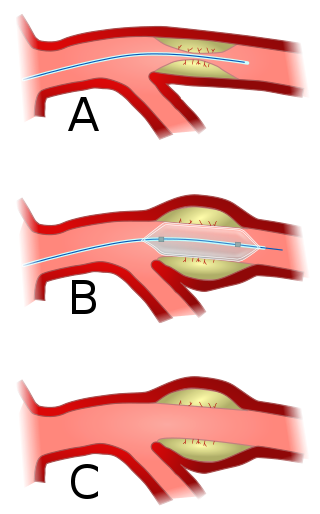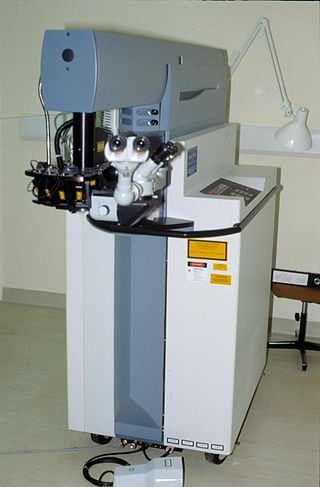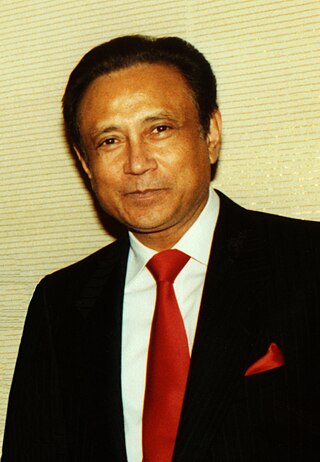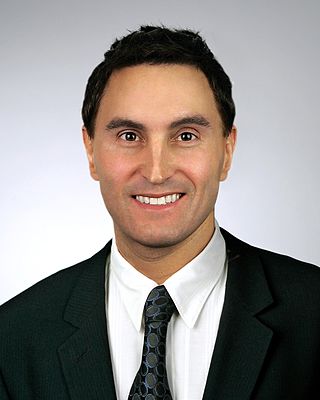Photolithography is a process used in the manufacturing of integrated circuits. It involves using light to transfer a pattern onto a substrate, typically a silicon wafer.

Angioplasty, also known as balloon angioplasty and percutaneous transluminal angioplasty (PTA), is a minimally invasive endovascular procedure used to widen narrowed or obstructed arteries or veins, typically to treat arterial atherosclerosis.

LASIK or Lasik, commonly referred to as laser eye surgery or laser vision correction, is a type of refractive surgery for the correction of myopia, hyperopia, and astigmatism. LASIK surgery is performed by an ophthalmologist who uses a femtosecond laser or a microkeratome to create a corneal flap to expose the corneal stroma and then an excimer laser to reshape the corneal stroma in order to improve visual acuity.

An excimer laser, sometimes more correctly called an exciplex laser, is a form of ultraviolet laser which is commonly used in the production of microelectronic devices, semiconductor based integrated circuits or "chips", eye surgery, and micromachining.

Refractive surgery is an optional eye surgery used to improve the refractive state of the eye and decrease or eliminate dependency on glasses or contact lenses. This can include various methods of surgical remodeling of the cornea (keratomileusis), lens implantation or lens replacement. The most common methods today use excimer lasers to reshape the curvature of the cornea. Refractive eye surgeries are used to treat common vision disorders such as myopia, hyperopia, presbyopia and astigmatism.

A krypton fluoride laser is a particular type of excimer laser, which is sometimes called an exciplex laser. With its 248 nanometer wavelength, it is a deep ultraviolet laser which is commonly used in the production of semiconductor integrated circuits, industrial micromachining, and scientific research. The term excimer is short for 'excited dimer', while exciplex is short for 'excited complex'. An excimer laser typically contains a mixture of: a noble gas such as argon, krypton, or xenon; and a halogen gas such as fluorine or chlorine. Under suitably intense conditions of electromagnetic stimulation and pressure, the mixture emits a beam of coherent stimulated radiation as laser light in the ultraviolet range.

Mani Lal Bhaumik is an Indian American physicist and an internationally bestselling author, celebrated lecturer, entrepreneur and philanthropist.

Mark Cohen is a Canadian laser eye surgeon who practices in Montreal and Toronto. In 2001, he and Avi Wallerstein founded LASIK MD, Canada's largest provider of laser refractive surgery. As of 2013, LASIK MD performs over sixty percent of all laser vision correction procedures in Canada. He is one of only 14 certified C-LASIK instructors in North America.

Avi Wallerstein is a Canadian ophthalmologist and laser eye surgeon who specializes in surgical vision correction, also termed refractive eye surgery. He practises in Montreal and Toronto. In 2001, he co-founded LASIK MD with Mark Cohen. LASIK MD is Canada's largest provider of laser refractive surgery, performing over 60,000 procedures a year. He is one of only 14 certified CLasik instructors in North America.
Samuel E. Blum was an American chemist and physicist. He was a researcher at the Battelle Memorial Institute in Columbus, Ohio, working for government and private companies. He worked with semiconductor materials, which was his specialization until his retirement from IBM Watson Research Center in 1990.
The argon fluoride laser is a particular type of excimer laser, which is sometimes called an exciplex laser. With its 193-nanometer wavelength, it is a deep ultraviolet laser, which is commonly used in the production of semiconductor integrated circuits, eye surgery, micromachining, and scientific research. "Excimer" is short for "excited dimer", while "exciplex" is short for "excited complex". An excimer laser typically uses a mixture of a noble gas and a halogen gas, which under suitable conditions of electrical stimulation and high pressure, emits coherent stimulated radiation in the ultraviolet range.
Stephen Updegraff, M.D., FACS is an American refractive surgeon best known for his early involvement in, and contributions to, LASIK. He is a Fellow of the American College of Surgeons, a board-certified member of the American Board of Ophthalmology, a founding member of the American College of Ophthalmic Surgeons, and a member of the International Society of Refractive Surgery, the American Academy of Ophthalmology, the American Society of Cataract and Refractive Surgery, and the Pine Ridge Eye Study Society. Updegraff currently serves as the medical director of Updegraff Vision in St. Petersburg, Florida.

Gholam A. Peyman is an Iranian American ophthalmologist, retina surgeon, and inventor. He is best known for his invention of LASIK eye surgery, a vision correction procedure designed to allow people to see clearly without glasses. He was awarded the first US patent for the procedure in 1989.
Jeffery J. Machat MD, FRCSC, DABO is an ophthalmologist in the United States and Canada specializing in surgical vision correction better known as refractive eye surgery. He is most known for being the Co-Founder of TLC Laser Eye Centers with Elias Vamvakas in 1993. The first TLC clinic was located in Windsor, Canada and treated thousands of patients from across all of North America. The clinic also hosted thousands of eye care specialists trying to learn about LASIK and PRK prior to US FDA approval which came three years later. Together Vamvakas and Machat built an incredible company of 83 LASIK clinics through both organic growth and strategic acquisition by May 2002 to become the largest provider of LASIK in North America. Dr. Machat pioneered not only LASIK but the concept of Optometric Comanagement throughout the 1990s, helping build a TLC network of over 14,000 referring optometrists by 2000. In 2005-2006, Machat spent time in Europe working to build Optical Express, helping David Moulsdale, owner and Founder, to transform the company from 300 optical stores into the leading provider of LASIK vision correction in Europe with 55 clinics in the span of 2 years.
Peter S. Hersh is an American ophthalmologist, researcher, and specialist in LASIK eye surgery, keratoconus, and diseases of the cornea. He co-authored the article in the journal Ophthalmology that presented the results of the study that led to the first approval by the U.S. Food and Drug Administration (FDA) of the excimer laser for the correction of nearsightedness in the United States. Hersh was also medical monitor of the study that led to approval of corneal collagen crosslinking for the treatment of keratoconus. He was the originator, in 2015, of CTAK for keratoconus, patent holder, and co-developer.
Raymond Mark Stein, MD, FRCSC, DABO, is a Canadian ophthalmologist. He practices refractive and cataract surgery. He is the medical director of the Bochner Eye Institute in Toronto, Ontario and Chief of Ophthalmology at the Scarborough General Hospital.
James J. Wynne is an American physicist at the IBM Watson Research Center in Yorktown Heights, NY.
The Katharine Burr Blodgett Medal and Prize is a gold medal awarded annually by the Institute of Physics to "recognise contributions to the organisation or application of physics in an industrial or commercial context." The medal is accompanied by a prize of £1000.

John Marshall MBE, FMedSci, PhD, DSc, FRCPath, FRSB, FRCOphth(Hon), FRCOptom (Hon), FARVO is a British medical scientist and inventor. Currently he is the Frost Professor of Ophthalmology at the Institute of Ophthalmology UCL and Emeritus Professor King's College London. He is a pioneer of laser eye surgery.

Ursula Keller is a Swiss physicist. She has been a physics professor at the ETH Zurich, Switzerland since 2003 with a speciality in ultra-fast laser technology, an inventor and the winner of the 2018 European Inventor Award by the European Patent Office.











